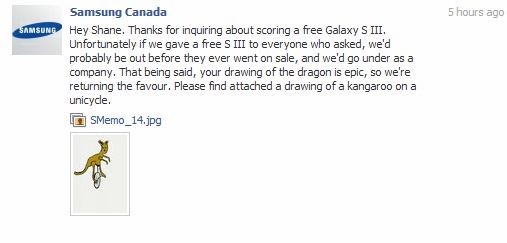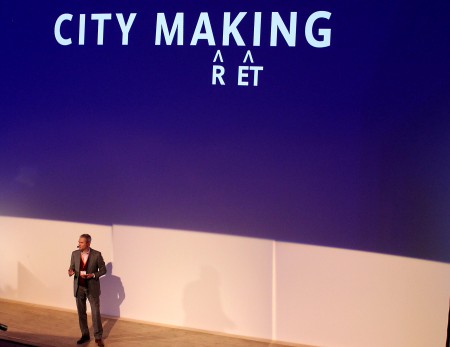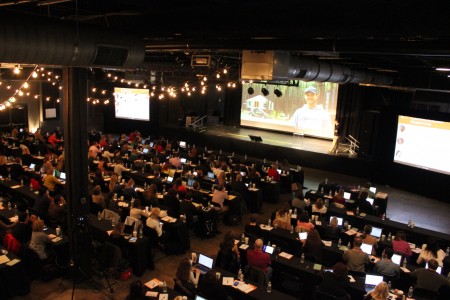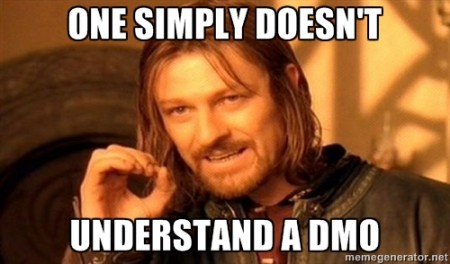Category
Marketing
-
Internet, Marketing
overload
There is a lot of information out there and it’s accessible anywhere. I remember the first time I settled an argument over a beer by Googling on my Blackberry (I won the argument by the way, Tony Hawk is taller than 6 feet). Marketers talk about how media fragmentation and information overload make it hard to reach consumers. But is it?
Clay Shirky once said about, “It’s Not Information Overload. It’s Filter Failure.”
Google and Bing are fixing this problem through search. By finding the intent behind somebody’s search, they create better filters to present relevant results. They personalize results based on your geographic location, your search history, your social graph and more. Google CEO Eric Smith (in)famously said:
<div class=”quote”>With your permission, you give us more information about you, about your friends, and we can improve the quality of our searches. We don’t need you to type at all. We know where you are. We know where you’ve been. We can more or less know what you’re thinking about.</div>
What can we learn from this? A lot.
A good filter separates relevant from irrelevant information. And relevancy is personal.
-
Internet, Marketing, social media, Travel & Tourism
Producing viral loops is your business objective

In 2005 my wife and I spent a month in Nepal. We trekked the Annapurna Trail through the Himalayas. It was one of the best experiences of our life. If you’ve seen any of my keynotes you’ve probably heard the story including our amazing guides Rajan and Mukti.
Without realizing it, we’ve moved a lot of our friends through the marketing funnel. We’ve told a lot of our friends about the trip (creating awareness about the experience). Some friends asked us more questions about the trek (they’re considering to do the trip one day) and others asked about the experience we had with our trekking company (they’re intending) and two of our friends (and partners) have since gone to Nepal and gone on a trek with the same company (purchase).
Our experience and satisfaction with Nepal and our trekking company created a viral loop. The two of us produced 4 new customers in 5 years. We created a positive viral loop.
-
Internet, Marketing, Travel & Tourism
DMO’s don’t need mobile apps
A mobile app requires marketing the app, costing time and money.
A mobile website is discoverable through links and search engines.
HTML5 can pretty much deliver pretty much anything a DMO mobile app can.
-
Internet, Marketing, social media
Don’t be so serious all the time
Going on a trip means seeing new things, meeting new people, tasting different food, making memories. It’s supposed to be fun! And as tourism marketers, it’s ok to have fun in public as well. And on the internet, you really have no choice. Here are a few examples.
White House
Somebody started a petition on whitehouse.gov suggesting the government to build a death star. The whitehouse response is hilarious! Including the title “This Isn’t the Petition Response You’re Looking For”
The Administration shares your desire for job creation and a strong national defense, but a Death Star isn’t on the horizon. Here are a few reasons:- The construction of the Death Star has been estimated to cost more than $850,000,000,000,000,000. We’re working hard to reduce the deficit, not expand it.
- The Administration does not support blowing up planets.
- Why would we spend countless taxpayer dollars on a Death Star with a fundamental flaw that can be exploited by a one-man starship?
Samsung
Someone ‘asked Samsung for a free phone. He posted on Samsung’s Facebook page and included a home drawn picture of dragon in return.
Samsung responded in style, with a picture of a kangaroo on a unicycle. Funny!
This caused a lot of PR for Samsung and they ended up sending a free phone anyways. With the dragon on it. Smart!
Thomas Cook
And then there’s Thomas Cook. A UK resident with the same name asked for a trip to Paris for all the grief he’s had over the years with a name like that.
Great to hear from you! Unfortunately we are unable to give away free holidays. Please see Thomascook.com for the best available price.
Stupid! Of course you can’t give everybody a free vacation but at least use some humour like Samsung did. Although in this case they should have jumped on it. What an opportunity wasted.
Lowcostholidays swooped in and gave Mr. Cook his trip to Paris, scoring a big PR win.
Moral of the story? Don’t be afraid to have some fun. And be quick when an opportunity arises. Marketing in 2013 demands it.
-
Management, Marketing, Travel & Tourism
Messages from #SoMeT14EU you can’t ignore
Know what you’re not
Sveinn Birkir Björnsson – Promote Iceland
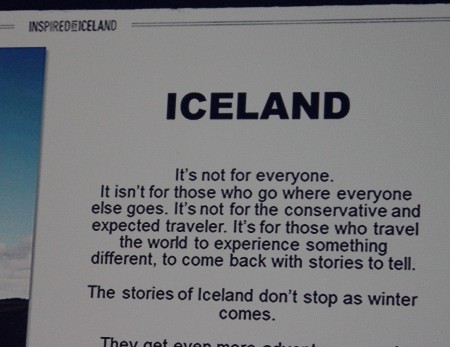
Sveinn demonstrated how a DMO can make a big impact on a smaller budget. It starts by understanding what you’re not and not being afraid to take a stand. How many DMOs claim to be “diverse”? How many DMOs claim to have “something for everybody”? Island doesn’t. And Island is not afraid to say so. As a result, the people that visit are much more likely to love the place. And when people that will probably love you visit, the stories they share in social media will be much stronger, building the right brand amongst their circles.
Manage your destination experience
Peter Kentie – Eindhoven 365You can leave it up to the Dutch to present the transition from destination marketing to destination management in a visually stimulating way. In Eindhoven, Peter isn’t city marketing, he’s city making. They are practicing the future role of the DMO. Very little promotion but instead play an active role in managing the destination experience.
Eindhoven also know what they are and what they’re not. They have defined their niches as technology, design and knowledge. Positioning the city in these niche groups and “turning up the volume” to engage visitors and generate the right stories. Even citywide Wifi has been thought off.
Develop a brand your residents connect with
Peter Kentie – Eindhoven 365Making your residents an active part of your promotional efforts is critical for a DMO. That’s why we recommend our clients to choose a destination hashtag that speaks to local pride for example. Eindhoven took it one step further by crowd sourcing their visual identity and pretty much open source it so others can use it for their purposes. The result is an identity people that’s used across the city connecting with people so strongly that some now carry tattoos with the logo. Have anyone in your destination a tattoo with you logo?
-
Experience Design, Marketing, Travel & Tourism
Paris locks itself out of a tourism motivator
06.01.15 | Permalink | 2 CommentsParis is removing the love locks from the Pont des Arts bridge.
For years couples have attached little padlocks to the bridge as a symbol of their love. Newlyweds or newly engaged couples travel from all over the world and one reason for their visit is to attach a lock to the bridge. But the bridge is collapsing under the weight of hundreds of thousands of locks. The city stepped in and and said “no more”.
I’ve written about this phenomenon before. Sharing experiences, traditions and superstitions are very powerful motivators. People throw coins in fountains, rub statues and kiss rocks for all kinds of reasons, all over the world. These traditions can be very powerful drivers for tourism, how strange this might sound. Travel often lacks a sense of urgency. You can visit most destinations any time in your life. Paris will still be Paris ten years from now. Mona Lisa will still be the same and so will the Eiffel Tower. But with a tradition tied to a life event such as engagement or marriage, the emotional connection acts as a catalyst.
Paris is putting a halt to it. I understand the safety concerns but here’s what I don’t get. They are taking away a strong motivator for travel. Why not give people an alternative? A new place to place a lock. It would be so simple. Hire an artist to create a sculpture with the purpose of attaching locks. Build it in a way you can remove locks from time to time. The coins from the Trevi fountain in Rome are also collected at night. I can guarantee that without an alternative, people will just move on to the next bridge, or not show up at all.
-
leadership, Management, Marketing, Travel & Tourism
The business case of attending a #SoMeT conference overseas
I have the privilege of attending our SoMeT conferences on three different continents. The learning is incredible. Both from the speaker content, and also from speaking to the attendees. It helps me a lot in my work.
A question I get asked a lot is if there are differences between DMOs in different parts of the world, their challenges and their approaches to solving them. The answer is: yes and no. The challenges are very similar but the approaches differ. I think the regional differences are partly cultural but also influenced by the “neighbour effect.” People pay close attention to the DMO next door, and then this is reflected in their own strategies and tactics.
For this reason, it’s interesting to attend a SoMeT conference on a different continent. You’ll see a different spotlight shone on familiar challenges. It can be very eye opening, and will inspire you to try new ideas and approaches. I know it does for me. Not to mention the fact you’ll also make new connections with your international peers.
It might be a tough sell to your boss or board. The optics and psychological barrier of an intercontinental flight (and costs) to go to a conference when there are options closer by is challenging. But when you put it in terms of value, the additional cost are minimal compared to the value it delivers. We’re talking a few hundred dollars.
So keep an eye on our conferences around the world and what they have to offer. #SoMeT15EU will be held in Amsterdam.
-
Management, Marketing, Travel & Tourism
Six things tourism businesses should know about their DMO
08.11.14 | Permalink | 35 CommentsI’ve worked at a destination marketing organization for 11 years, and have spent the last 4 years at Think! where I’ve worked with more than 100 DMOs from all around the world. And a big challenge for every DMO is managing their industry stakeholders. The politics. Proving value and relevancy.
Even if well-intended, I don’t think industry stakeholders truly understand how their actions can impact the efficiency and effectiveness of their DMO.
If you’re a tourism business, this is what you should know about DMOs:
1) A rising tide lifts all boats
You might compete with other businesses in your destination, but the reality is that when more people want to visit your destination, everybody benefits. That’s the marketing job of the DMO. To get more people there, get them to stay longer and spend more money. Your DMO needs to focus on the things that make your destination unique and the things that make people want to visit. You might not like it, but some experiences/businesses are more important drivers for tourism than others.
Don’t take the view that that big attraction doesn’t need additional exposure, because you’re completely missing the point. The Eiffel Tower makes people want to visit Paris, while the café down the street probably doesn’t. Tourism Paris needs to promote the Eiffel Tower, not the cafe, lovely as it might be.
What you should do: let the DMO work by focussing on the things that will make business better for everybody, even if that means giving more exposure to certain products than others.
(And while we’re on the subject: if your hotel/restaurant/tour etc is booked out when a visitor enquires, why not recommend a trusted partner business? You’re not losing business to a competitor, you’re gaining a visitor to your destination and working together to raise all boats.)
2) A DMO isn’t responsible for your sales
With the exception of few cases, your DMO shouldn’t put their time and effort into selling things. It’s a waste of resources. Once someone makes the decision to visit, there are legions of other places where people can buy packages, flights, hotel rooms, etc. These organizations are much better at it than your DMO. Your DMO doesn’t need to do this.
What you should do: Don’t see your DMO as a sales channel. Your DMO sells the destination experience, not tickets or reservations.
(Note: some city DMOs have very successful booking systems, ticket services and city card programs, but these are the exceptions.)
3) DMOs need to take a long-term view
As a tourism business, you worry about next month’s sales. And if they don’t look good, you might look at your DMO to try and fix it. In some cases, that’s valid (think the BP oil spill). But in most cases, it’s not. Your DMO should take a long-term view (especially your state/provincial/national DMO) to build your brand, reputation and demand for the long term. If they don’t, other destinations will win in the long run.
What you should do: Let your DMO take a long-term view for the ongoing growth of tourism in your destination.
4) People working at the DMOs are passionate about you and your business
DMOs are often publicly funded. That comes with specific complications. They’re under a lot of political and press scrutiny. If they make a “mistake”, it can be used by politicians in the opposition, or result in negative press. Both can have very bad impacts on funding.
This situation can make things frustrating for you. But guess what, your DMO people are often very frustrated by bureaucracy…they just won’t tell you that. I’ve worked at, spoken to and worked with hundreds of people working for these organizations and they’re almost always the most dedicated professionals who understand their responsibilities. They love where they live, what they do and want to make you successful.
What you should do: Lose the scepticism, and learn to collaborate and support the staff of your DMO. They’re good people who need your support, especially when they’re impacted by politics and press.
5) Stop evaluating marketing based on how it looks
It’s very easy to have an opinion about marketing based on what it looks like. “I like this ad/I don’t like that one/I like the colour of this website/I don’t like that one.” Often this involves the competition. “Those TV ads from Destination X look much better than ours”. Or worse: “Why don’t we advertise on TV, the way the DMO next door does?”
Because industry stakeholders pay so much attention to how things look, a DMO will often pay more attention to what their industry might think instead of what is most effective for the potential visitor. They’ll even ignore marketing such as Google Ads, email marketing or social media because they need the budget for TV or something. It’s often not because they want to, it’s because you make them, directly or indirectly.
What you should so: Don’t judge your DMO’s marketing based on how it looks. Focus on objectives and results. Be open minded about where and how they market your destination. The world of marketing has changed.
6) Embrace failures
That doesn’t make sense, right? Actually it does. In order to learn, you need to win… but you also need to lose. Michael Jordan missed a lot of shots and once said “I’ve failed over and over and over again in my life. And that is why I succeed.”
As a marketer you need to experiment in order find out what works and what doesn’t. There are too many DMOs out there afraid to do anything different or innovative because they’re afraid. Afraid that if it doesn’t work out, industry stakeholders, media or politicians will criticize the efforts, and their funding (or jobs) could be in jeopardy. As a result, DMOs are often very risk-averse, resort to being safe and old-fashioned, with mediocrity as a result.
What you should do: accept failures as long as they’re used to make things better in the future. Also, defend your DMO from media and politicians when things don’t work as planned.
Any other suggestions, or examples where your businesses have supported your DMO? Share them with me here!
-
Internet, Marketing, Travel & Tourism
Unbundling the DMO web and mobile strategy

Last week Foursquare announced it is going to split its mobile application into two. One is focused on discovering new places and the other (Swarm) will be focused on helping users share their location with their friends. They join Dropbox, who unbundled photo storage in a separate app (Carousel), Facebook, who unbundled their chat functionality from their main app, and others. They also join other companies who offer apps such as HotelTonight and Uber who also focus on a single-use case.
Most DMOs have “one-size-fits-all” websites and mobile apps that cover everything, for everybody. It’s easier to build and maintain one website, template and its content. I used to hate microsites when I worked at Tourism BC for that very reason. But as a result, DMO websites are often big beasts that are inflexible, hard and expensive to maintain after all.
Things have changed. Technology is ambiguous. Content is incredibly fragmented and apps and services similarly specialized. Content is abundant. DMOs need to be storytellers. You’re still the experts in your destination. But instead of focusing on being the experts on what time a museum opens, be the expert on the context of your destination. You know: the culture, history and the people. Be the destination storyteller and add value.
What if we unbundle our destination into very specific niches and build incredibly targeted apps or web experiences (mobile first) for our users? What if we put somebody in charge of these applications who is just as passionate about the niche as your visitors? What if it includes real-time information and social integration?
For example: an app for foodies. Not just listings but the story of the restaurants including menus, profiles of the chefs, reviews from prominent bloggers (you hire to produce this content), information about local farmers and food from the destination, recommended itineraries, etc. An app that adds incredible value to the food experience. An app that tells the story of food in your destination before and during the trip.
Another example: architecture. I’m a bit of a fan of architecture but by no means an expert. I love to wander a city and look at the and wonder about the style, history, etc. What about an app that explains all this? That shows photos of buildings the way they looked when they were build? Stories about their history. The architect. The style. Walking routes. Things that add value. Things that make the destination experience better. An app that would make me stay an extra day after a business meeting, just to wander around and learn.
Or music! An app that tells you about the music scene. Interviews with bands and links to their tracks. The venues and their stories. Interviews with the owners. Real-time information about who’s playing where and why you might like them. Information about the scene around music. The record stores. The bars. An app that adds value to the destination experience. An app that gives you an instant feel for the scene before I go and an instant connection with it when I arrive.
Some are venturing in: Visit Oostende has created a Marvin Gaye iPad app of a walking tour through Oostende. Marvin Gaye lived in this Belgian coastal town for about a year and wrote and recorded “Sexual Healing” there. The DMO created a wonderful experiences for Marvin Gaye fans, fans into music and soul, as well as people curious about this piece of it’s history.
Do you need other examples? No.
It’s not just about listings. It’s about context. Unbundle for niches, talk to visitors in a more meaningful way.
-
leadership, Marketing, Travel & Tourism
Picking the right conference to learn the most and make the best connections
01.28.14 | Permalink | 4 Comments
My past (red) and upcoming (green) speaking gigsI’ve spoken at dozens of conferences and attended dozens more. I’ve been to really good ones, I’ve been to bad ones and I’ve been to some where it was all about the money. We (at Think!) also run our SoMeT conference in the US, Australia and Europe.
Here are my guidelines for picking the right conference:
- Find your peers: the best part of a conference is often the networking. Find conferences where you can connect or reconnect. I remember that from my DMO days. SoMeT, for example, offers more of a community and the conference also serves as a yearly reunion of friends. So ask around, see what your peers will be attending.
- No sales pitches: too many conferences sell presentations, and you’ll end up listening to sales pitches. Avoid conferences where (too many) speakers are also sponsors.
- Look for DMO (or non-vendor) speakers: These people have nothing to sell to you. And case studies are typically the way to learn. The nice thing about our industry is that people share a lot of learning with each other.
- Find presenters you like, don’t look at the title of the presentation: Conference organizers will often make up titles without the presenters’ knowledge. Look for speakers you know and respect. Research the keynote speaker’s blog and see what they’ve posted on Slideshare.
- Avoid too many panels: Panels are hard to pull off. You need a good moderator and engaging panelists. It’s rare when it happens. People are too nice and polite. When I’m on a panel, I make a point of trying to stir things up for that very reason.
Based on the guidelines above, I also design my presentations and avoid any direct sales pitches for Think! I share what I know and what I’ve learned – which is just what I like to see from a presenter. I always, always worry about giving people enough value, not the amount of business cards I collect.
That’s also how we run our SoMeT conferences. We make sure there are plenty of networking opportunities, we don’t sell speaker slots, we invite tons of leading DMOs from around the world to speak and use panels sporadically.
If I had one conference I could attend a year, I would attend a digital tourism conference that follow my rules above.
If I could attend two, I would pick one outside the tourism industry on a specialized topic. So not SXSW for example. I would pick a conference specific to word-of-mouth marketing, social media, UX design, service design, gamification, content marketing, SEO/SEM, etc.
Hope to see you out there soon.

